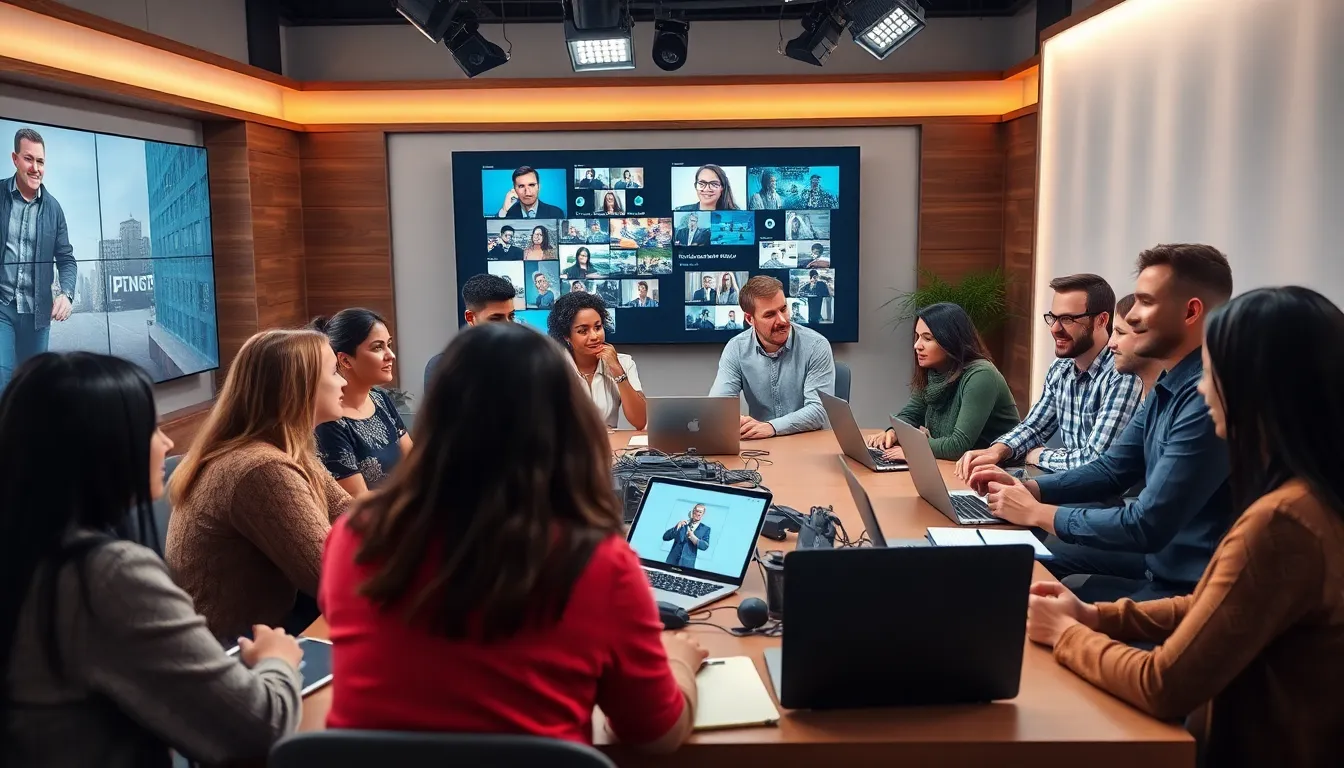In today’s fast-paced digital landscape, media ownership plays a crucial role in shaping public perception and influencing societal narratives. As a handful of corporations dominate the airwaves and online platforms, understanding who controls the media becomes increasingly important. This concentration of power raises questions about diversity, representation, and the integrity of information.
With the rise of social media and streaming services, the dynamics of media ownership are evolving, creating new challenges and opportunities. As audiences seek authentic voices and varied perspectives, the implications of ownership structures become more pronounced. This article delves into the complexities of media ownership, exploring its impact on content creation and consumption in a rapidly changing world.
Table of Contents
ToggleOverview of Media Ownership
Media ownership refers to the control of media outlets and platforms, significantly affecting the dissemination of information. In the current landscape, five major corporations—Comcast, Disney, AT&T, ViacomCBS, and Fox—dominate nearly 90% of the United States media market. This concentration raises concerns regarding diverse viewpoints and representation in news coverage and entertainment offerings.
The shift toward digital platforms has further complicated media ownership structures. Social media companies, such as Facebook and Twitter, have become essential for news distribution, influencing how information circulates and shaping public discourse. These platforms operate under different ownership models, often prioritizing profit motives over journalistic integrity.
Regulatory frameworks vary globally, impacting media diversity and accessibility. In some regions, stringent ownership limits promote pluralism, while in others, lax regulations facilitate monopolistic practices. Understanding these dynamics aids in recognizing how ownership influences the creation, presentation, and reception of media content.
Technological advancements have also enabled new players to enter the media space. Independent creators and smaller organizations leverage digital tools to disseminate content, challenging traditional media hierarchies. The emergence of user-generated content platforms emphasizes the importance of community voices, illustrating potential pathways for diversifying media ownership.
The Importance of Media Ownership

Media ownership critically influences the landscape of content diversity and public opinion. Understanding its role reveals the impacts on societal narratives and democratic discourse.
Impact on Content Diversity
Media ownership concentration limits content diversity. With a few corporations controlling significant media outlets, alternative viewpoints and niche stories often receive insufficient attention. This concentration hinders the representation of various communities and perspectives. According to a 2021 report by the Pew Research Center, around 80% of U.S. media is controlled by five conglomerates. Independent voices struggle to gain traction in mainstream media channels, decreasing the variety of narratives available to audiences. Digital platforms enable independent creators to address this gap, yet their reach often remains overshadowed by corporate media.
Influence on Public Opinion
Media ownership significantly shapes public opinion. Corporations often prioritize certain narratives to align with their interests, influencing how issues are portrayed. This prioritization affects people’s perceptions and understanding of current events. Research from the Knight Foundation indicates that media bias, typically reflecting ownership interests, substantially impacts audience beliefs and behavior. Furthermore, when a select few dominate media platforms, they steer public discourse, often marginalizing dissenting viewpoints. As audiences increasingly rely on social media for news, the role of algorithms, driven by corporate profit motives, further complicates the integrity of information presented.
Historical Context of Media Ownership
Media ownership has evolved significantly over the decades, shaped by technological advancements and changing societal norms. Understanding the historical context offers insight into current media dynamics and ownership structures.
Traditional Media Ownership Models
Traditional media ownership models primarily consisted of monopolies and oligopolies. In the early to mid-20th century, few entities dominated radio and television broadcasting. Networks like NBC, CBS, and ABC held substantial control, dictating news and entertainment access. The Federal Communications Commission (FCC) established regulations aimed at preventing monopolistic practices, yet concentrated ownership persisted. By 1983, 90% of U.S. media was owned by 50 corporations, highlighting a troubling trend toward further consolidation.
Ownership structures often favored particular political ideologies, further skewing content towards specific audiences. Advertiser interests heavily influenced programming and editorial decisions, leading to the prevalent notion that media serves corporate agendas rather than public interest. This model limited diverse perspectives and marginalized dissenting voices.
The Rise of Digital Media Ownership
The digital age radically transformed media ownership dynamics. Social media platforms and streaming services emerged as powerful players by the turn of the 21st century. Companies like Facebook, Google, and Netflix began reshaping how content is created, distributed, and consumed, challenging traditional media’s long-standing dominance. In 2019, about 69% of U.S. adults reported using social media, making it a crucial news source.
Digital platforms emphasize user-generated content and algorithms that prioritize engagement over accurate news reporting. This shift has led to the rise of independent creators and influencers, who often drive narratives outside established media channels. However, the concentration of ownership within the tech industry poses risks similar to traditional media, as a few corporations dictate online content availability and visibility.
The Federal Trade Commission (FTC) and FCC are now grappling with regulatory frameworks to address these complexities. The emergence of digital media ownership has spawned new challenges related to data privacy, misinformation, and the monopolistic tendencies of tech giants, necessitating ongoing scrutiny of the evolving media landscape.
Current Trends in Media Ownership
Media ownership trends reflect ongoing shifts influenced by technological advancements and changes in consumer behavior. Key trends include the consolidation of media companies and the emergence of independent media and alternative ownership models.
Consolidation of Media Companies
Consolidation remains a significant trend in media ownership, resulting in fewer entities controlling a majority of media outlets. The U.S. media landscape sees giants like Comcast, Disney, and AT&T acquiring smaller companies, which further concentrates power. In 2022, a report from the Federal Communications Commission highlighted that just a handful of corporations control nearly 90% of broadcast media, continuously narrowing the scope of diverse viewpoints.
Such consolidation leads to reduced competition. Consequently, concentration harms content diversity, limiting the representation of underrepresented communities and marginalized voices. Media mergers often prioritize profitability over diversity, driving content that caters to mainstream narratives, which risks further homogenizing public discourse.
Independent Media and Alternative Ownership Models
Despite consolidation challenges, independent media and alternative ownership models emerge as viable counterweights. Crowdfunding platforms and cooperative ownership structures provide new avenues for media creation. Outlets like ProPublica and The Guardian US demonstrate successful frameworks based on editorial independence, prioritizing public interest over corporate agendas.
Cooperative models enable communities to actively participate in content creation and decision-making processes. Initiatives like INN (Investigative News Network) foster collaboration among small independent newsrooms, enhancing resource sharing and editorial diversity. Social media platforms additionally empower independent journalists to reach audiences directly, bypassing traditional gatekeepers.
The growth of independent media reflects a pressing demand for diverse narratives and scrutiny of conventional media biases. In an evolving media landscape, alternative ownership structures continue to expand, demonstrating potential pathways to enhance representation and accountability in journalism.
The Future of Media Ownership
The landscape of media ownership continues to evolve, shaped by new technologies and consumer preferences. The future presents both challenges and opportunities that will significantly impact the way information is produced and consumed.
Challenges and Opportunities
Consolidation poses a primary challenge in the media industry. Major corporations continue acquiring smaller outlets, concentrating ownership and limiting diverse viewpoints. This trend restricts competition, undermining content variety and fostering echo chambers that reinforce existing narratives.
Emerging technologies provide opportunities for independent media. Platforms like crowdfunding sites and social media enable creators to share alternative perspectives. Innovative models such as cooperatives empower communities to support local journalism directly. Successful examples include ProPublica and The Guardian US, which prioritize public interest over profit.
In response to the challenges posed by dominant corporations, collaborative initiatives like the Investigative News Network (INN) enhance resource sharing among small independent newsrooms, fostering a diverse range of editorial voices and promoting accountability in reporting.
Policy Implications and Regulation
Regulatory frameworks influence future media ownership dynamics. Current policies often fail to address the rapid changes in the digital landscape, leaving room for monopolistic practices among tech giants that dominate content distribution. Effective regulation is essential for encouraging diversity and ensuring fair competition.
The Federal Communications Commission (FCC) and the Federal Trade Commission (FTC) must adapt to emerging challenges posed by digital platforms. Developing policies that address data privacy, misinformation, and corporate influence will prove crucial. Strengthening antitrust regulations can help dismantle monopolistic structures, paving the way for more diverse media ownership models.
Engaging in ongoing discussions regarding media regulation holds importance for promoting transparency and accountability within the industry. By prioritizing the interests of consumers and underrepresented communities, policymakers can encourage a more equitable media landscape that reflects a multitude of perspectives.
Media ownership remains a critical factor in shaping public discourse and perception. The concentration of power among a few corporations continues to limit diversity and representation in content. As technology evolves and consumer habits shift, independent media is gaining traction, offering fresh perspectives and alternative narratives.
Policymakers must recognize the urgency of fostering a more equitable media landscape. Regulatory frameworks need to adapt to the challenges posed by both traditional media and emerging digital platforms. By prioritizing diversity and accountability, the media can better reflect the rich tapestry of society’s voices. The future of media ownership will depend on balancing corporate interests with the public’s need for varied and honest information.







